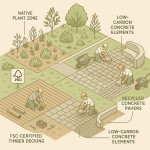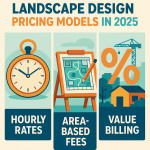Client onboarding roadmap in landscape design: smooth briefs to long-term care
A friction-free onboarding sequence turns curious prospects into life-long landscape-design clients. Follow this roadmap to collect the right information, align expectations early and pave the way for profitable maintenance contracts.
Why a structured onboarding process is mission-critical
Landscape projects stretch across seasons, budgets and stakeholder groups. Without a clear onboarding framework, misaligned expectations surface halfway through grading, or worse, during post-install maintenance. A documented roadmap helps you:
- Position your studio as strategic, not transactional.
- Capture every site nuance before design begins.
- Shorten proposal cycles by up to 40 %—a benchmark echoed in the 2025 pricing guide.
- Create upsell pathways to care plans that generate predictable revenue.
Phase 1 – Discovery & context audit
Site walk-through and stakeholder interviews
Block two hours on site with decision-makers and facility teams. Capture:
- Soil composition and drainage maps.
- Existing flora health and invasive species.
- Utility line locations and easements.
- User flows: staff entrances, deliveries, leisure pockets.
Photograph each zone and geotag the files. High-resolution location data later feeds into drone overlays—techniques detailed in our article on GIS & drone mapping.
Risk and opportunity matrix
Create a two-column table for quick reference.
| Risk | Mitigation Opportunity |
|---|---|
| Poor drainage on north lawn | Rain garden design + grant eligibility |
| Heat island effect near parking | High-albedo pavers & canopy trees |
| Lack of pollinator habitats | Native meadow installation |
Phase 2 – Vision brief that eliminates ambiguity
Transform discovery data into a concise, visual brief. Keep it under ten pages with:
- Aerial site plan with annotated pain-points.
- Inspirational mood board illustrating planting palettes.
- Programmatic requirements (events, vehicular access, security).
- Sustainability targets with reference standards like SITES or LEED.
Email the PDF and host an interactive review on a video call. Obtain written sign-off before drafting costs.
Phase 3 – Proposal & value alignment

Visualizing the moment when designer and client align on scope often clarifies why a three-tier proposal outperforms a single flat fee. Picture a sunlit patio stage where planting diagrams hover above a tablet, budget sliders move in real time and carbon-footprint metrics glow beside lush renderings. That instant of shared understanding sets the emotional hook that turns an optional care plan into an obvious choice. By depicting the value conversation as an interactive scene, you reinforce the narrative that maintenance is not an add-on but the logical finale of a well-orchestrated outdoor story.
Quote three tiers—concept only, concept + installation, concept + installation + care. Clients comparing bids grasp the long-term value instantly when maintenance is woven into the initial scope. For credibility around eco-choices, link to material certificates, echoing the approach in sustainable material sourcing plans.
Fee transparency table
| Package | Includes | Investment (USD) |
|---|---|---|
| Seed | Concept + 2 revisions | 8 500 |
| Grow | Seed + install oversight | 26 000 |
| Thrive | Grow + 12-month care | 32 500 |
Phase 4 – Kick-off workshop
Once the agreement is e-signed, invite primary stakeholders to a 90-minute kick-off. Agenda:
- Revisit goals and success metrics (biodiversity index, water savings).
- Define communication cadence—weekly email digest, monthly site walk.
- Introduce project management tools (Asana, Trello or a shared BIM cloud).
- Confirm decision-making hierarchy to avoid design-by-committee delays.
Phase 5 – Design development with micro-feedback loops
Break the design phase into three sprints:
- Concept refinement: 3D massing and view corridors.
- Planting strategy: bloom calendar, micro-climate mapping.
- Technical drawings: grading, irrigation, lighting.
Each sprint concludes with a mini-review. This agile rhythm cuts revision rounds by 50 %, freeing billable hours for higher-margin tasks such as enhancing your online directory profile.
Phase 6 – Handover & maintenance roadmap
Installation is only half the story. Provide a comprehensive handover pack:
- As-built drawings in PDF and DWG.
- Plant passport with Latin names, sizes and supplier warranties.
- Irrigation schedules and controller codes.
- Seasonal task calendar (pruning, fertilising, mulching).
Embed a QR code on the final plan linking to the live maintenance tracker hosted on your studio's Artfolio profile. Clients appreciate centralised information, and you gain a backlink that bolsters authority.
Long-term care packages: converting installs into recurring revenue
Pitch maintenance services 30 days before project completion. Use curated packages inspired by the seasonal maintenance roadmap. Example tiers:
- Essential Care – monthly visits covering mowing, edging, debris removal.
- Proactive Care – Essential + quarterly soil testing and pest control.
- Signature Care – Proactive + annual redesign of feature beds.
Bundle remote monitoring via soil-moisture sensors and drone fly-overs to deliver data-driven reports that justify the ongoing fee.
Common onboarding pitfalls—and how to avoid them
- Scope creep: Counter with a signed vision brief and change-order form.
- Delays in approvals: Nominate a single client spokesperson at kick-off.
- Budget shocks: Present optional upgrades separately from core deliverables.
- Maintenance gaps: Offer training sessions for in-house groundskeepers if a care plan isn't selected.
Tools & templates that save time
Below is a starter kit you can adapt:
| Template | Purpose | Format |
|---|---|---|
| Site-audit checklist | Standardise discovery | Google Sheets |
| Vision brief deck | Condense insights | PowerPoint |
| Tiered proposal | Transparent pricing | PDF + e-sign |
| Maintenance task calendar | Year-round care | iCal import |
Quick self-test: Are you onboarding like a pro?
FAQ
- How long does a full landscape onboarding process take?
- Most studios complete the six phases in 6–10 weeks, assuming prompt client feedback.
- Can I skip the kick-off workshop?
- You could, but studios that omit it report twice as many scope-change requests. The workshop pays for itself in saved revisions.
- What if a client declines a maintenance plan?
- Offer a paid handover training session and schedule a follow-up call in six months. Many clients reconsider once they grasp upkeep complexity.
- Is software required for micro-feedback loops?
- No, but a shared project board accelerates approvals. Free tools like Trello are sufficient for smaller projects.
- How can I prove ROI of my onboarding process?
- Track proposal acceptance rates and post-install issue tickets. Studios implementing this roadmap often see a 20 % rise in repeat contracts.
Next step
Ready to streamline your own client journey? Download the free site-audit checklist and start implementing these phases today.











